A Review of Nonlinear Mechanisms for Frequency Up-Conversion in Energy Harvesting
Abstract
:1. Introduction
2. Piezoelectric Vibration Energy Harvesting (PVEH)
3. Nonlinear Systems
3.1. Snap-Through Buckling (STB) Mechanisms
| Mechanism | Authors | Year | Frequency or Velocity Range | Transduction |
|---|---|---|---|---|
| Snap-through buckling | Masana and Daqaq [57] | 2011 | 10–100 Hz | Piezoelectric |
| Cottone et al. [56] | 2013 | 20–106 Hz | Electromagnetic | |
| Xu et al. [60] | 2019 | 10–100 Hz | Piezoelectric | |
| Speciale et al. [51] | 2020 | 20–30 Hz | Piezoelectric | |
| Impact-based | Umeda et al. [65] | 1996 | N.A. * | Piezoelectric |
| Alghisi et al. [66] | 2015 | 10–100 Hz | Piezoelectric | |
| Halim et et al. [67] | 2019 | 5.2 Hz | Piezo-electromagnetic | |
| Nastro et al. [68] | 2022 | around 4 Hz | Piezoelectric | |
| Mechanical plucking | Pozzi and Zhu [69] | 2012 | 0.1–1 Hz | Piezoelectric |
| Janphuang et al. [70] | 2015 | 3–19 Hz | Piezoelectric | |
| Kathpalia et al. [71] | 2018 | N.A. * | Piezoelectric | |
| Fu and Liao [72] | 2019 | 0.1–2 m/s | Piezoelectric | |
| Magnetic interaction broadband and plucking | Stanton et al. [73] | 2009 | 10–16 Hz | Piezoelectric |
| Erturk and Inman [74] | 2011 | 5–7 Hz (broadband) | Piezoelectric | |
| Fu and Yeatman [75] | 2019 | 1–11 Hz | Piezoelectric | |
| Lo et al. [76] | 2021 | 5–15 Hz | Piezoelectric | |
| Miao et al. [77] | 2022 | 0.5–5 Hz | Electromagnetic | |
| Others | Leadenham and Erturk [78] | 2014 | 10–20 Hz (broadband) | Piezo-electromagnetic |
| Nie et al. [79] | 2019 | 7.5–17.5 Hz | Piezoelectric | |
| Wang et al. [80] | 2021 | 1–20 Hz | Piezoelectric | |
| Rosso et al. [32] | 2022 | 1–6 Hz | Piezoelectric |
3.2. Impact-Based Mechanisms
3.3. Mechanical Plucking-Based Frequency Up-Conversion Mechanisms
3.4. Magnetic Interaction Broadband and Plucking Mechanisms
3.5. Other Types of Nonlinearities
3.6. Nonlinearities through Electronics Circuit
4. Conclusions
Author Contributions
Funding
Conflicts of Interest
References
- Corigliano, A.; Ardito, R.; Comi, C.; Frangi, A.; Ghisi, A.; Mariani, S. Mechanics of Microsystems; John Wiley & Sons: Hoboken, NJ, USA, 2018. [Google Scholar]
- Bri, D.; Yeatman, E.; Roundy, S. Micro Energy Harvesting; Wiley-VCH: Weinheim, Germany, 2015. [Google Scholar]
- Williams, C.B.; Yates, R.B. Analysis of a micro-electric generator for microsystems. Sens. Actuators A 1996, 52, 8–11. [Google Scholar] [CrossRef]
- Roundy, S.; Wright, P.K.; Rabaey, J.M. Energy Scavenging for Wireless Sensor Networks with Special Focus on Vibrations; Springer: Berlin/Heidelberg, Germany, 2004. [Google Scholar]
- Wang, L.; Yuan, F.G. Vibration energy harvesting by magnetostrictive material. Smart Mater. Struct. 2008, 17, 045009. [Google Scholar] [CrossRef]
- Saha, O.; Andersen, E.; Roundy, S. Wireless Power Transfer by Self-biased Magnetoelectric Laminate for Biomedical Implants. In Proceedings of the 2021 IEEE 20th International Conference on Micro and Nanotechnology for Power Generation and Energy Conversion Applications (PowerMEMS), Exeter, UK, 6–8 December 2021. [Google Scholar]
- Borkar, H.; Gaikwad, V.M.; Dutta, S.; Tomar, M.; Gupta, V.; Kumar, A. Lead-free laminated structures for eco-friendly energy harvesters and magnetoelectric sensors. J. Phys. Chem. Solids 2022, 160, 110306. [Google Scholar] [CrossRef]
- Lallart, M.; Cottinet, P.J.; Guyomar, D.; Lebrun, L. Electrostrictive Polymers for Mechanical Energy Harvesting. J. Polym. Sci. Part B Polym. Phys. 2012, 50, 523–535. [Google Scholar] [CrossRef]
- Liu, Y.; Ren, K.L.; Hofman, H.F.; Zhang, Q. Investigation of electrostrictive polymers for energy harvesting. IEEE Trans. Ultrason. Ferroelectr. Freq. Control 2005, 52, 2411–2417. [Google Scholar] [PubMed]
- Erturk, A.; Inman, D.J. Piezoelectric Energy Harvesting; John Wiley & Sons: Hoboken, NJ, USA, 2011. [Google Scholar]
- Cook-Chennault, K.A.; Thambi, N.; Sastry, A.N. Powering MEMS portable devices—A review of non-regenerative and regenerative power supply systems with special emphasis on piezoelectric energy harvesting systems. Smart Mater. Struct. 2008, 17, 043001. [Google Scholar] [CrossRef]
- Safaei, M.; Sodano, H.A.; Anton, S.R. A review of energy harvesting using piezoelectric materials: State-of-the-art a decade later (2008–2018). Smart Mater. Struct. 2019, 28, 113001. [Google Scholar] [CrossRef]
- Beeby, S.P.; Tudor, M.J.; White, N.M. Energy harvesting vibration sources for microsystems applications. Meas. Sci. Technol. 2006, 17, R175–R195. [Google Scholar] [CrossRef]
- Roundy, S. Energy Scavenging for Wireless Sensor Nodes with a Focus on Vibration to Electricity Conversion. Ph.D. Thesis, University of California, Berkeley, CA, USA, 2003. [Google Scholar]
- Roundy, S.; Wright, P.; Pister, K. Micro-electrostatic vibration-to-electricity converters. In Proceedings of the IMECE 2002, New Orleans, LA, USA, 17–22 November 2002; pp. 1–10. [Google Scholar]
- Miao, P.; Mitcheson, P.D.; Holmes, A.S.; Yeatman, E.M.; Green, T.C.; Stark, B.H. Mems inertial power generators for biomedical applications. Microsyst. Technol. 2006, 12, 1079–1083. [Google Scholar] [CrossRef]
- Basset, P.; Galayko, D.; Cottone, F.; Guillemet, R.; Blokhina, E.; Marty, F.; Bourouina, T. Electrostatic vibration energy harvester with combined effect of electrical nonlinearities and mechanical impact. J. Micromech. Microeng. 2014, 24, 035001. [Google Scholar] [CrossRef]
- Anton, S.R.; Sodano, H.A. A review of power harvesting using piezoelectric materials (2003–2006). Smart Mater. Struct. 2007, 16, R1. [Google Scholar] [CrossRef]
- Anton, S.R.; Erturk, A.E.; Inman, D.J. Bending Strength of Piezoelectric Ceramics and Single Crystals for Multifunctional Load-Bearing Applications. IEEE Trans. Ultrason. Ferroelectr. Freq. Control 2012, 59, 1085–1092. [Google Scholar] [CrossRef] [PubMed]
- Pillatsch, P.; Xiao, B.L.; Shashoua, N.; Gramling, H.M.; Yeatman, E.M.; Wright, P.K. Degradation of bimorph piezoelectric bending beams in energy harvesting applications. Smart Mater. Struct. 2017, 26, 035046. [Google Scholar] [CrossRef]
- Stojčev, M.K.; Kosanović, M.R.; Golubović, L.R. Power management and energy harvesting techniques for wireless sensor nodes. In Proceedings of the TELKSIS 2009, Nish, Serbia, 11 February 2009; pp. 65–72. [Google Scholar]
- Chalasani, S.; Conrad, J. A survey of energy harvesting sources for embedded systems. In Proceedings of the IEEE Southeastcon, Huntsville, Alabama, 3–6 April 2008; pp. 442–447. [Google Scholar]
- Anton, S.R.; Inman, D.J. Vibration energy harvesting for unmanned aerial veichles. Proc. SPIE 2008, 6928, 621–632. [Google Scholar]
- Anton, S.R. Multifunctional Piezoelectric Energy Harvesting Concepts. Ph.D. Thesis, Virginia Polytechninc Institute and State University, Blacksburg, VA, USA, 2011. [Google Scholar]
- Anton, S.R.; Erturk, A.E.; Inman, D.J. Multifunctional Unmanned Aerial Veichle Wing Spar for Low-Power Generation and Storage. J. Aircr. 2012, 49, 292–301. [Google Scholar] [CrossRef]
- Hoummadi, E.; Safei, M.; Anton, S.R. Design, Analysis, and Fabrication of a Piezoelectric Force Plate. Health Monit. Struct. Biol. Syst. Proc. SPIE 2017, 10170, 182–192. [Google Scholar]
- Safei, M.; Meneghini, R.M.; Anton, S.R. Energy Harvesting and Sensing with Embedded Piezoelectric Ceramics in Knee Implants. IEEE/ASME Trans. Mechatronics 2018, 23, 864–874. [Google Scholar] [CrossRef]
- Lallart, M.; Anton, S.R.; Inman, D.J. Frequency Self-tuning Scheme for Broadband Vibration Energy Harvesting. J. Intell. Mater. Syst. Struct. 2010, 21, 897–906. [Google Scholar] [CrossRef]
- duToit, N.E.; Wardle, B.L.; Kim, S.G. Design Considerations for MEMS-Scale Piezoelectric Mechanical Vibration Energy Harvesters. Integr. Ferroelectr. 2005, 71, 121–160. [Google Scholar] [CrossRef]
- Roundy, S. On the effectiveness of vibration-based energy harvesting. J. Intell. Mater. Syst. Struct. 2005, 16, 809–823. [Google Scholar] [CrossRef]
- Blokhina, E.; El Aroudi, A.E.; Alarcon, E.; Galayko, D. Nonlinearity in Energy Harvesting Systems, Micro- and Nanoscale Applications; Springer: Cham, Switzerland, 2016. [Google Scholar]
- Rosso, M.; Nastro, A.; Baù, M.; Ferrari, M.; Ferrari, V.; Corigliano, A.; Ardito, R. Piezoelectric Energy Harvesting from Low-Frequency Vibrations Based on Magnetic Plucking and Indirect Impacts. Sensors 2022, 22, 5911. [Google Scholar] [CrossRef]
- Antonsson, E.K.; Mann, R.W. The frequency content of the gait. J. Biomech. 1985, 18, 39–47. [Google Scholar] [CrossRef] [PubMed]
- Antaki, J.F.; Bertocci, G.E.; Green, E.C.; Nadeem, A.; Rintoul, T.; Kormos, R.L.; Griffith, B. A Gait-Powered Autologous Battery Charging System for Artificial Organs. ASAIO J. 1995, 41, M588–M595. [Google Scholar] [CrossRef] [PubMed]
- Erturk, A.; Hoffmann, J.; Inman, D.J. A piezomagnetoelastic structure for broadband vibration energy harvesting. Appl. Phys. Lett. 2009, 94, 254102. [Google Scholar] [CrossRef]
- Cottone, F.; Vocca, H.; Gammaitoni, L. Nonlinear Energy Harvesting. Phys. Rev. Lett. 2009, 102, 080601. [Google Scholar] [CrossRef]
- Huygens, C. Horologium Oscillatorium: Sive de Motu Pendulorum ad Horologia Aptato Dimostrationes Geometricae. 1673. Available online: https://www.christies.com.cn/en/lot/lot-5855958 (accessed on 5 December 2023).
- Lacarbonara, W. Obituary: Professor Ali H. Nayfeh 21 December 1933-27 March 2017. J. Sound Vib. 2017, 400, 680–683. [Google Scholar] [CrossRef]
- Rega, G. Nonlinear dynamics in mechanics and engineering: 40 years of developments and Ali H. Nayfeh’s legacy. Nonlinear Dyn. 2020, 99, 11–34. [Google Scholar] [CrossRef]
- Daqaq, M.F.; Masana, R.; Erturk, A.; Quinn, D.D. On the Role of Nonlinearities in Vibratory Energy Harvesting: A Critical Review and Discussion. Appl. Mech. Rev. 2014, 66, 040801. [Google Scholar] [CrossRef]
- Leadenham, S.; Erturk, A. Unified nonlinear electroelastic dynamics for a bimorph piezoelectric cantilever for energy harvesting, sensing, and actuation. Nonlinear Dyn. 2015, 79, 1727–1743. [Google Scholar] [CrossRef]
- Rosso, M.; Kohtanen, E.; Corigliano, A.; Ardito, R.; Erturk, A. Nonlinear phenomena in magnetic plucking of piezoelectric vibration energy harvesters. Sens. Actuators A Phys. 2023, 362, 114667. [Google Scholar] [CrossRef]
- Rosso, M.; Ardito, R. The effect of inherent nonlinearities in coupled piezo-magneto-electric vibration energy harvester. Adv. Multiphys. Model. Simul. Electromagn. Syst. 2023, 2. [Google Scholar] [CrossRef]
- Bažant, Z.; Cedolin, L. Stability of Structures: Elastic, Inelastic, Fracture and Damage Theories; World Scientific Publishing: Singapore, 2010. [Google Scholar]
- Vangbo, M. An Analytical analysis of a compressed bistable buckled beam. Sens. Actuators A 1998, 69, 212–216. [Google Scholar] [CrossRef]
- Qiu, J.; Lang, J.H.; Slocum, A.H. A centrally-Clamped Parallel-Beam Bistable MEMS Mechanism. Technical Digest. MEMS 2001. In Proceedings of the 14th IEEE International Conference on Micro Electro Mechanical Systems (Cat. No. 01CH37090), Interlaken, Switzerland, 7 August 2001; pp. 353–356. [Google Scholar]
- Qiu, J.; Lang, J.H.; Slocum, A.H. A Curved-Beam Bistable Mechanism. J. Microelectromech. Syst. 2004, 13, 137–145. [Google Scholar] [CrossRef]
- Frangi, A.; De Masi, B.; Baldasarre, L. Shock Sensor with Bistable Mechanism and Method of Shock Detection. U.S. Patent 9316550, 19 April 2016. [Google Scholar]
- Frangi, A.A.; De Masi, B.; Confalonieri, F.; Zerbini, S. Threshold Shock Sensor Based on a Bistable Mechanism: Design, Modeling, and Measurements. J. Microelectromech. Syst. 2015, 24, 2019–2026. [Google Scholar] [CrossRef]
- Jung, S.M.; Yun, K.S. Energy-harvesting device with mechanical frequency-up conversion mechanism for increased power efficiency and wideband operation. Appl. Phys. Lett. 2010, 96, 111906. [Google Scholar] [CrossRef]
- Speciale, A.; Ardito, R.; Baù, M.; Ferrari, M.; Ferrari, V.; Frangi, A. Snap-Through Buckling Mechanism for Frequency-up Conversion in Piezoelectric Energy Harvesting. Appl. Sci. 2020, 10, 3614. [Google Scholar] [CrossRef]
- Baker, J.; Roundy, S.; Wright, P. Alternative Geometries for Increasing Power Density in Vibration Energy Scavenging for Wireless Sensor Networks. In Proceedings of the 3rd International Energy Conversion Engineering Conference, San Francisco, CA, USA, 15–18 August 2005; Volume 1. [Google Scholar]
- Cottone, F.; Gammaitoni, L.; Vocca, H.; Ferrari, M.; Ferrari, V. Piezoelectric buckled beams for random vibration energy harvesting. Smart Mater. Struct. 2012, 21, 3614. [Google Scholar] [CrossRef]
- Fu, H.; Khodaei, Z.S.; Aliabadi, M.F. Broadband energy harvesting using bi-stability and frequency up-conversion for self-powered sensing in internet of things. In Proceedings of the Transducers 2019—EUROSENSORS XXXIII, Berlin, Germany, 23–27 June 2019; pp. 354–357. [Google Scholar]
- Yi, Z.; Tian, Y.; Dong, X.; Liu, J.; Yang, B. Vertically integrated double buckled-bridge for softening nonlinear piezoelectric energy harvester. In Proceedings of the Transducers 2019—EUROSENSORS XXXIII, Berlin, Germany, 23–27 June 2019; pp. 1435–1438. [Google Scholar]
- Cottone, F.; Basset, P.; Vocca, H.; Gammaitoni, L.; Bourouina, T. Bistable electromagnetic generator based on buckled beams for vibration energy harvesting. J. Intell. Mater. Syst. Struct. 2014, 25, 1485–1495. [Google Scholar] [CrossRef]
- Masana, R.; Daqaq, M.F. Relative Performances of a vibratory energy harvester in mono- and bi-stable potentials. J. Sound Vib. 2011, 330, 6036–6052. [Google Scholar] [CrossRef]
- Masana, R.; Daqaq, M.F. Energy harvesting in the super-harmonic frequency region of a twin-well oscillator. J. Appl. Phys. 2012, 11, 044051. [Google Scholar] [CrossRef]
- Masana, R.; Daqaq, M.F. Response of duffing-type harvesters to band-limited noise. J. Sound Vib. 2013, 332, 6755–6767. [Google Scholar] [CrossRef]
- Xu, R.; Akay, J.; Kim, S.-G. Buckled MEMS beams for Energy Harvesting from Low Frequency Vibrations. Research 2019, 2019, 1087946. [Google Scholar] [CrossRef]
- Andò, B.; Baglio, S.; Bulsara, A.R.; Marletta, V. A bistable buckled beam based approach for vibrational energy harvesting. Sens. Actuators A Phys. 2014, 211, 153–161. [Google Scholar] [CrossRef]
- Andò, B.; Baglio, S.; Marletta, V.; Pistorio, A.; Bulsara, A.R. A Low Threshold Bistable Device for Energy Scavenging from Vibrations. In Proceedings of the 2016 IEEE Sensors Applications Symposium (SAS), Catania, Italy, 20–22 April 2016. [Google Scholar]
- Andò, B.; Baglio, S.; Marletta, V.; Pistorio, A.; Bulsara, A.R. A Low-Threshold Bistable Device for Energy Scavenging from Wideband Mehchanical Vibrations. IEEE Trans. Instrum. Meas. 2019, 68, 280–290. [Google Scholar] [CrossRef]
- Arrieta, A.F.; Hagedorn, P.; Erturk, A.; Inamn, D.J. A piezoelectric bistable plate for nonlinear broadband energy harvesting. Appl. Phys. Lett. 2010, 97, 104102. [Google Scholar] [CrossRef]
- Umeda, M.; Nakamura, K.; Ueha, S. Analysis of the Transformation of Mechanical Impact Energy to Electric Energy Using Piezoelectric Vibrator. Jpn. J. Appl. Phys. 1996, 35, 3267. [Google Scholar] [CrossRef]
- Alghisi, D.; Dalola, S.; Ferrari, M.; Ferrari, V. Triaxial ball-impact piezoelectric converter for autonomous sensors exploiting energy harvesting from vibrations and human motion. Sens. Actuators A Phys. 2015, 233, 569–581. [Google Scholar] [CrossRef]
- Halim, M.A.; Kabir, M.H.; Cho, H.; Park, J.Y. A Frequency Up-Converted Hybrid Energy Harvester Using Transverse Impact-Driven Piezoelectric Bimoprh for Human-Limb Motion. Micromachines 2019, 10, 701. [Google Scholar] [CrossRef]
- Nastro, A.; Pienazza, N.; Baù, M.; Aceti, P.; Rouvala, M.; Ardito, R.; Ferrari, M.; Corigliano, A.; Ferrari, V. Wearable Ball-Impact Piezoelectric Multi-Converters for Low-Frequency Energy Harvesting from Human Motion. Sensors 2022, 22, 772. [Google Scholar] [CrossRef]
- Pozzi, M.; Zhu, M. Characterization of a rotary piezoelectric energy harvester based on plucking excitation for knee-joint wearable applications. Smart Mater. Struct. 2012, 21, 055004. [Google Scholar] [CrossRef]
- Janphuang, P.; Lockhart, R.A.; Isarakon, D.; Henein, S. Harvesting Energy From a Rotating Gear Using an AFM-Like MEMS Piezoelectric Frequency Up-Converting Energy Harvester. J. Microelectromech. Syst. 2015, 24, 742–754. [Google Scholar] [CrossRef]
- Kathpalia, B.; Tan, D.; Stern, I.; Erturk, A. An experimentally validated model for geometrically nonlinear plucking-based frequency up-conversion in energy harvesting. Smart Mater. Struct. 2018, 27, 015024. [Google Scholar] [CrossRef]
- Fu, X.; Liao, W.H. Modeling and Analysis of Piezoelectri Energy Harvesting With Dynamic Plucking Mechanism. J. Vib. Acoust. 2019, 141, 031002. [Google Scholar] [CrossRef]
- Stanton, S.C.; McGehee, C.C.; Mann, B.P. Reversible hysteresis for broadband magnetopiezoelastic energy harvesting. Appl. Phys. Lett. 2009, 95, 174103. [Google Scholar] [CrossRef]
- Erturk, A.; Inman, D.J. Broadband piezoelectric power generation on high-energy orbits of the bistable Duffing oscillator with electromechanical coupling. J. Sound Vib. 2011, 330, 2339–2353. [Google Scholar] [CrossRef]
- Fu, H.; Yeatman, E.M. Rotational energy harvesting using bi-stability and frequency up-conversion for low-power sensing applications: Theoretical modelling and experimental validation. Mech. Syst. Signal Process. 2019, 125, 229–244. [Google Scholar] [CrossRef]
- Lo, Y.C.; Chen, C.C.; Shu, Y.C.; Lumentut, M.F. Broadband piezoelectric energy harvesting induced by mixed resonant modes under magnetic plucking. Smart Mater. Struct. 2021, 30, 105026. [Google Scholar] [CrossRef]
- Miao, G.; Fang, S.; Wang, S.; Zhou, S. A low-frequency rotational electromagnetic energy harvester using a magnetic plucking. Appl. Energy 2022, 305, 117838. [Google Scholar] [CrossRef]
- Leadenham, S.; Erturk, A. M-shaped asymmetric nonlinear oscillator for broadband vibration energy harvesting: Harmonic balance analysis and experimental validation. J. Sound Vib. 2014, 333, 6209–6223. [Google Scholar] [CrossRef]
- Nie, X.; Tan, T.; Yan, Z.; Yan, Z.; Hajj, M.R. Broadband and high efficient L-shaped piezoelectric energy harvester based on the internal resonance. Int. J. Mech. Sci. 2019, 159, 287–305. [Google Scholar] [CrossRef]
- Wang, Z.; He, L.; Zhang, Z.; Zhou, Z.; Zhou, J.; Cheng, G. Research on a Piezoelectric Energy Harvester with Rotating Magnetic Excitation. J. Electron. Mater. 2021, 50, 3228–3240. [Google Scholar] [CrossRef]
- Blalock, T.J. The frequency charger era—Interconnecting systems of varying cycles. IEEE Power Energy Mag. 2003, 1, 72–79. [Google Scholar] [CrossRef]
- Yadav, R.; Dahiya, P.K.; Mishra, R. Design of Combined Mixer IF Filter for Low Voltage and Low Power Automotive Radar Application. Intern. J. Comput. Eng. Manag. 2018, 21, 2230–7893. [Google Scholar]
- PJI. Boeing 737-700: 400 Hz AC Aircraft Ground Power Units—Used and New. Website 2022. Available online: https://pilotjohn.com/a/boeing/737-700/aircraft-gse/ground-power/400-hz-ac-aircraft-ground-power-units (accessed on 5 December 2023).
- Psc Power. Website 2022. Available online: https://www.pscpower.com/wp-content/uploads/2019/04/What-is-Frequency-Conversion.pdf (accessed on 5 December 2023).
- Aceti, P.; Rosso, M.; Ardito, R.; Pienazza, N.; Nastro, A.; Baù, M.; Ferrari, M.; Rouvala, M.; Ferrari, V.; Corigliano, A. Optimization of an impact-based frequency up-converted piezoelectric vibration energy harvester for wearable devices. Sensors 2023, 23, 1391. [Google Scholar] [PubMed]
- Ferrari, M.; Baù, M.; Cerini, F.; Ferrari, V. Impact-Enhanced Multi-Beam Piezoelectric Converter for Energy Harvesting in Autonomous Sensors. Procedia Eng. Eurosens. XXVI 2012, 47, 418–421. [Google Scholar] [CrossRef]
- Gu, L.; Livermore, C. Impact-driven, frequency up-converting coupled vibration energy harvesting device for low frequency operation. Smart Mater. Struct. 2011, 20, 045004. [Google Scholar] [CrossRef]
- Ju, S.; Ji, C.H. Impact-Based piezoelectric vibration energy harvester. Appl. Energy 2018, 214, 139–151. [Google Scholar] [CrossRef]
- Dechant, E.; Fedulov, F.; Chasin, D.V.; Fetisov, L.Y.; Fetisov, Y.K.; Shanomin, M.S. Low-Frequency, broadband vibration energy harvester using coupled oscillators and frequency up-conversion by mechanical stoppers. Smart Mater. Struct. 2017, 26, 065021. [Google Scholar] [CrossRef]
- Febbo, M.; Machado, S.P. Rotational multi-beam energy harvester with up-conversion mechanism in an extremely low frequency scenario. Mech. Syst. Signal Process. 2022, 168, 108737. [Google Scholar] [CrossRef]
- Pozzi, M.; Zhu, M. Plucked piezoelectric bimorphs for knee-joint energy harvesting: Modelling and experimental validation. Smart Mater. Struct. 2011, 20, 055007. [Google Scholar] [CrossRef]
- Pozzi, M.; Aung, M.S.H.; Zhu, M.; Jones, R.K.; Goulermas, J.Y. The pizzicato knee-joint energy harvester: Characterization with biomechanical data and the effect of backpack load. Smart Mater. Struct. 2012, 21, 075023. [Google Scholar] [CrossRef]
- Kathpalia, B. Methods of piezoelectric energy harvesting from human body motions. Master’s Thesis, George W. Woodruff School of Mechanical Engineering, Georgia Institute of Technology, Atlanta, GA, USA, 2018. [Google Scholar]
- Janphuang, P.; Isarakorn, D.; Bri, D.; RooiJ, N.F. Energy harvesting from a rotating gear using an impact type piezoelectric MEMS scavenger. In Proceedings of the IEEE TRANSDUCERS 2011—2011 16th International Solid-State Sensors, Actuators and Microsystems Conference, Beijing, China, 5–9 June 2011. [Google Scholar]
- Pozzi, M. Magnetic plucking of piezoelectric bimporphs for a wearable energy harvester. Smart Mater. Struct. 2016, 25, 045008. [Google Scholar] [CrossRef]
- Rosso, M.; Corigliano, A.; Ardito, R. Numerical and experimental evaluation of the magnetic interaction for frequency up-conversion in piezoelectric vibration energy harvesters. Meccanica 2022, 57, 1139–1154. [Google Scholar] [CrossRef]
- Moon, F.C.; Holmes, P.J. A Magnetoelastic strange attractor. J. Sound Vib. 1979, 65, 275–296. [Google Scholar] [CrossRef]
- Holmes, P. A nonlinear oscillator with a strange attractor. Philos. Trans. R. Soc. Lond. Ser. A 1979, 292, 419–449. [Google Scholar]
- Erturk, A. Electromechanical Modeling of Piezoelectric Energy Harvesters. Ph.D. Thesis, Virginia Polytechnic Institute and State University, Blacksburg, VA, USA, 2009. [Google Scholar]
- Nayfeh, A.H.; Mook, D.T. Nonlinear Oscillations; Wiley-VCH: Weinheim, Germany, 1995. [Google Scholar]
- Kovacic, I.; Brennan, M.J. The Duffing Equation: Nonlinear Oscillators and Their Behaviour; John Wiley & Sons: Hoboken, NJ, USA, 2011. [Google Scholar]
- Ferrari, M.; Ferrari, V.; Guizzetti, M.; Marioli, D. A Single-Magnet Nonlinear Piezoelectric Converter for Enhanced Energy Harvesting from Random Vibrations. Procedia Eng. 2010, 5, 1156–1159. [Google Scholar] [CrossRef]
- Ferrari, M.; Ferrari, V.; Guizzetti, M.; Ando, B.; Baglio, S.; Trigona, C. Improved energy harvesting from wideband vibrations by nonlinear piezoelectric converters. Sens. Actuators A 2010, 162, 425–431. [Google Scholar] [CrossRef]
- Tang, L.; Yang, Y.; Soh, C.K. Improving functionality of vibration energy harvesters using magnets. J. Intell. Mater. Syst. Struct. 2012, 23, 1433–1449. [Google Scholar] [CrossRef]
- Tang, L.; Yang, Y. A nonlinear piezoelectric energy harvester with magnetic oscillator. Appl. Phys. Lett. 2012, 101, 094102. [Google Scholar] [CrossRef]
- Fan, K.; Tan, Q.; Liu, H.; Zhang, Y.; Cai, M. Improved energy harvesting from low-frequency small vibrations through a monostable piezoelectric energy harvester. Mech. Syst. Signal Process. 2019, 117, 594–608. [Google Scholar] [CrossRef]
- Rezaei, M.; Talebitooti, R.; Lio, W.H. Investigations on magnetic bistable PZT-based absorber for concurrent energy harvesting and vibration mitigation: Numerical and analytical approaches. Energy 2022, 239, 122376. [Google Scholar] [CrossRef]
- Mei, X.; Zhou, R.; Yang, B.; Zhou, S.; Nakano, K. Combining magnet-induced nonlinearity and centrifugal softening effect to realize high-efficiency energy harvesting in ultralow-frequency rotation. J. Sound Vib. 2021, 505, 116146. [Google Scholar] [CrossRef]
- Wickenheiser, A.M.; Garcia, E. Broadband vibration-based energy harvesting improvement through frequency up-conversion by magnetic excitation. Smart Mater. Struct. 2010, 19, 065020. [Google Scholar] [CrossRef]
- Zhou, S.; Lallart, M.; Erturk, A. Multistable vibration energy harvesters: Principle, progress, and perspectives. J. Sound Vib. 2022, 528, 116886. [Google Scholar] [CrossRef]
- Jiang, J.; Liu, S.; Feng, L.; Zhao, D. A Review of piezoelectric Vibration Energy Harvesting with Magnetic Coupling Based on Different Structural Characterisitcs. Micromachines 2021, 12, 436. [Google Scholar] [CrossRef] [PubMed]
- Ju, Y.; Li, Y.; Tan, J.; Zhao, Z.; Wang, G. Transition mechanism and dynamics behavoirs of a multi-stable piezoelectric energy harvester with magnetic interaction. J. Sound Vib. 2021, 501, 116074. [Google Scholar] [CrossRef]
- Wang, C.; Zhang, Q.; Wang, W. Low-frequency wideband vibration energy harvesting by using frequency up-conversion and quin-stable nonlinearity. J. Sound Vib. 2017, 399, 169–181. [Google Scholar] [CrossRef]
- Tao-Hai, L.; Bo-Jian, D.; Fan, C.; Wei-Yang, Q.; Lan-Rui, T. Homoclinic bifurcation for a bi-stable piezoelectric energy harvester subjected to galloping and base excitations. Appl. Math. Model. 2022, 104, 228–242. [Google Scholar] [CrossRef]
- Kim, J.; Dorin, P.; Wang, K.W. Vibration Energy Harvesting Enhancement Exploiting Magnetically Coupled Bistable and Linear Harvesters. Smart Mater. Struct. 2020, 29, 065006. [Google Scholar] [CrossRef]
- Koszewnik, A.; Oldziej, D.; Amaro, M.B. Parameter Optimization of a Magnetic Coupled Piezoelectric Energy Harvester with the Homogenized Material-Numerical Approach and Experimental Study. Sensors 2022, 22, 4073. [Google Scholar] [CrossRef]
- Yang, W.; Towfighian, S. Internal resonance and low frequency vibration energy harvesting. Smart Mater. Struct. 2017, 26, 095008. [Google Scholar] [CrossRef]
- Sun, W.; Jang, H.; Seok, J. Magnetically coupled piezoelectric galloping-based energy harvester using a tandem configuration. Mech. Syst. Signal Process. 2021, 161, 107952. [Google Scholar] [CrossRef]
- Chandwani, J.; Somkuwar, R.; Deshmukh, R. Experimental study on band merging of non-linear multi-band piezoelectric energy harvester into single broadband using magnetic coupling. Microsyst. Technol. 2020, 26, 657–671. [Google Scholar] [CrossRef]
- Wu, X.; Lee, D.W. Miniaturized piezoelectric energy harvester for battery-free portable electronics. Int. J. Energy Res. 2018, 43, 657–671. [Google Scholar] [CrossRef]
- Baù, M.; Alghisi, D.; Dalola, S.; Ferrari, M.; Ferrari, V. Multi-frequency array of nonlinear piezoelectric converters for vibration energy harvesting. Smart Mater. Struct. 2020, 29, 045947. [Google Scholar] [CrossRef]
- Haghighi, E.F.; Ziaei-Rad, S.; Nahvi, H. Energy harvesting from a nonlinear magnet-piezolectric multi-frequency converter array. Smart Mater. Struct. 2021, 30, 105028. [Google Scholar] [CrossRef]
- Li, P.; Xu, N.; Gao, C. Design and experimental study of broadband hybrid energy harvester with frequency-up conversion and nonlinear magnetic force. Microsyst. Technol. 2019, 26, 1707–1716. [Google Scholar] [CrossRef]
- Tang, Q.C.; Yang, Q.C.; Li, X. Bi-stable frequency up-conversion piezoelectric energy harvester driven by non-contact magnetic repulsion. Smart Mater. Struct. 2011, 20, 125011. [Google Scholar] [CrossRef]
- Pillatsch, P.; Yeatman, E.M.; Holmes, A.S. A piezoelectric frequency up-converting energy harvester with rotating proof mass for human body applications. Sens. Actuators A Phys. 2014, 206, 178–185. [Google Scholar] [CrossRef]
- Pillatsch, P.; Yeatman, E.M.; Holmes, A.S. Magnetic beam plucking in a piezoelectric energy harvester with rotating proof mass. In Proceedings of the PowerMEMS 2012, Atlanta, GA, USA, 20–30 April 2012; Volume 206, pp. 476–479. [Google Scholar]
- Ramezanpuor, R.; Nahvi, H.; Ziaei-Rad, S. Electromechanical behavior of pendulum-based piezoelectric frequency up-converting energy harvester. J. Sound Vib. 2016, 370, 280–305. [Google Scholar] [CrossRef]
- Ramezanpuor, R.; Nahvi, H.; Ziaei-Rad, S. A vibration-based energy harvester suitable for low-frequency, high-amplitude environments: Theoretical and experimental investigations. J. Intell. Mater. Syst. Struct. 2016, 27, 642–665. [Google Scholar] [CrossRef]
- Xue, T.; Roundy, S. On magnetic plucking configurations for frequency up-converting mechanical energy harvesters. Sens. Actuators A Phys. 2017, 253, 101–111. [Google Scholar] [CrossRef]
- Shu, Y.C.; Wang, W.C.; Chang, Y.P. Electrically rectified piezoelectric energy harvesting induced by a rotary magnetic plucking. Smart Mater. Struct. 2018, 27, 125006. [Google Scholar] [CrossRef]
- Dauksevicius, R.; Kleiva, A.; Grigaliunas, V. Analysis of magnetic plucking dynamics in a frequency up-converting piezoelectric energy harvester. Smart Mater. Struct. 2018, 27, 085016. [Google Scholar] [CrossRef]
- Mei, X.; Zhou, S.; Yang, Z.; Kaizuka, T.; Nakano, K. A quad-stable piezoelectric energy harvesting from rotational motion: Theoretical model and experiments. Model. Mech. Mater. 2019, 531, 012010. [Google Scholar]
- Mei, X.; Zhou, S.; Yang, Z.; Kaizuka, T.; Nakano, K. Enhancing energy harvesting in low-frequency rotational motion by a quad-stable energy harvester with time-varying potential wells. Mech. Syst. Signal Process. 2021, 148, 107167. [Google Scholar] [CrossRef]
- Xie, Z.; Xiong, J.; Zhang, D.; Wang, T.; Shao, Y.; Huang, W. Design and Experimental Investigation of a Piezoelectric Rotation Energy Harvester Using Bistable and Frequency Up-Conversion. Appl. Sci. 2018, 8, 1418. [Google Scholar] [CrossRef]
- Rosso, M.; Kohtanen, E.; Corigliano, A.; Ardito, R.; Erturk, A. Dynamical behavior of frequency up-converted piezoelectric vibration energy harvesters at different velocities of magnetic interaction. In Proceedings of the 2022 IEEE 21th International Conference on Micro and Nanotechnology for Power Generation and Energy Conversion Applications (powerMEMS), Salt Lake City, UT, USA, 12–15 December 2021; pp. 260–263. [Google Scholar]
- Dai, X.; Wang, H.; Wu, H.; Pan, Y.; Luo, D.; Ahemd, A.; Zhang, Z. A hybrid harvesting system for self-powered applications in shared bicycles. Sustain. Energy Technol. Assess. 2022, 51, 101891. [Google Scholar] [CrossRef]
- Gammaitoni, L.; Vocca, H.; Amico, P. Bistable Piezoelectric Generator. EP 2487732A2 Patent, 11 February 2008. [Google Scholar]
- Procopio, F.; Valzasina, C.; Corigliano, A.; Ardito, R.; Gafforelli, G. Piezoelectric Transducer for an Energy-Harvesting System. U.S. Patent 20150035409A1, 2 May 2015. [Google Scholar]
- Bodduluri, M.T.; Dankwort, T.; Lisec, T.; Grünzig, S.; Khare, A.; Ahmed, M.; Gojdka, B. Fully Integrated High-Performance MEMS Energy Harvester for Mechanical and Contactless Magnetic Excitation in Resonance and at Low Frequencies. Micromachines 2022, 13, 863. [Google Scholar] [CrossRef]
- Cammarano, A.; Neild, S.A.; Burrow, S.G.; Inman, D.J. The bandwidth of optimized nonlinear vibration-based energy harvesters. Smart Mater. Struct. 2014, 23, 055019. [Google Scholar] [CrossRef]
- Zou, D.; Liu, G.; Rao, Z.; Tan, T.; Zhang, W.; Liao, W.H. Design of vibration energy harvesters with customized nonlinear forces. Mech. Syst. Signal Process. 2021, 153, 107526. [Google Scholar] [CrossRef]
- Pan, J.; Qin, W.; Deng, W.; Zhang, P.; Zhou, Z. Harvesting weak vibration energy by integrating piezoelectric inverted beam and pendulum. Energy 2021, 227, 120374. [Google Scholar] [CrossRef]
- Izadgoshasb, I.; Lim, Y.Y.; Tang, L.; Padilla, R.V.; Tang, Z.S.; Sedighi, M. Improving efficiency of piezoelectric based energy harvesting from human motions using double pendulum system. Energy Convers. Manag. 2019, 184, 559–570. [Google Scholar] [CrossRef]
- Wu, Y.; Li, S.; Fan, K.; Ji, H.; Qiu, J. Investigation of an ultra-low frequency piezoelectric energy harvester with high frequency up-conversion factor caused by internal resonance mechanism. Mech. Syst. Signal Process. 2022, 162, 108038. [Google Scholar] [CrossRef]
- Hajati, A.; Kim, S.G. Ultra-wide bandwidth piezoelectric energy harvesting. Appl. Phys. Lett. 2011, 99, 083105. [Google Scholar] [CrossRef]
- Gafforelli, G.; Corigliano, A.; Xu, R.; Kim, S.G. Experimental verification of a bridge-shaped, nonlinear vibration energy harvester. Appl. Phys. Lett. 2014, 105, 203901. [Google Scholar] [CrossRef]
- Gafforelli, G.; Corigliano, A.; Xu, R.; Kim, S.G. Modeling of a Bridge-Shaped Nonlinear Piezoelectric Energy Harvester. Energy Harvest. Syst. 2014, 1, 179–187. [Google Scholar] [CrossRef]
- Wang, Z.; Matova, S.; Elfrink, R.; Jambunathan, M.; de Nooijer, C.; van Schaijk, R.; Vullers, J.M. A piezoelectric vibration harvester based on clamped-guided beams. In Proceedings of the MEMS 2012, Paris, France, 14–18 May 2012; pp. 1201–1204. [Google Scholar]
- Leadenham, S. Advanced Concepts in Nonlinear Piezoelectric Energy Harvesting: Intentionally Designed, Inherently Present, and Circuit Nonlinearities. Ph.D. Thesis, Georgia Institute of Technology, Atlanta, GA, USA, 2015. [Google Scholar]
- Nabavi, S.; Zhang, L. Design and Optimization of Wideband Multimode Piezoelectric MEMS Vibration Energy Harvesters. Proceedings 2017, 1, 586. [Google Scholar]
- Wang, X.; Chen, C.; Wang, N.; San, H.; Yu, Y.; Halvorsen, E.; Chen, X. A frequency and bandwidth tunable piezoelectric vibration energy harvester using multiple nonlinear techniques. Appl. Energy 2017, 190, 368–375. [Google Scholar] [CrossRef]
- Margielewicz, J.; Gaska, D.; Litak, G.; Wolszczak, P.; Trigona, C. Nonlinear Dynamics of a Star-Shaped Structure and Variable Configuration of Elastic Elements for Energy Harvesting Applications. Sensors 2022, 22, 2518. [Google Scholar] [CrossRef]
- Margielewicz, J.; Gaska, D.; Litak, G.; Wolszczak, P.; Yurchencko, D. Nonlinear Dynamics of a new energy harvesting system with quasi-zero stiffness. Appl. Energy 2022, 307, 118159. [Google Scholar] [CrossRef]
- Ngo, T.H.; Chi, I.T.; Chau, M.Q.; Wang, D.A. An Energy Harvester Based on a Bistable Origami Mechanism. Int. J. Precis. Eng. Manuf. 2022, 23, 213–226. [Google Scholar] [CrossRef]
- Nayfeh, A.H.; Balachandran, B. Modal interactions in dynamical and structural systems. Appl. Mech. Rev. 1979, 42, S175–S201. [Google Scholar] [CrossRef]
- Balachandran, B.; Nayfeh, A.H. Observations of Modal Interactions in Resonantly Forced Beam-Mass Structures. Nonlinear Dyn. 1991, 2, 77–117. [Google Scholar] [CrossRef]
- Haddow, A.G.; Barr, A.D.S.; Mook, D.T. Theoretical and experimental study of modal interaction in a two-degree-of-freedom structure. J. Sound Vib. 1984, 97, 451–473. [Google Scholar] [CrossRef]
- Nayfeh, A.H.; Zavodney, L.D. Experimental observation of amplitude- and phase-modulated responses of two internally coupled oscillators to a harmonic excitation. J. Appl. Mech. 1988, 55, 706–711. [Google Scholar] [CrossRef]
- Nayfeh, A.H.; Balachandran, B. Experimental investigation of resonantly forced oscillations of a two-degree-of-freedom structure. Int. J. Nonlinear Mech. 1990, 25, 199–209. [Google Scholar] [CrossRef]
- Abdelkefi, A.; Najar, F.; Nayfeh, A.H.; Ben Ayed, A. An energy harvester using piezoelectric cantilever beams undergoing coupled bending-torsion vibrations. Smart Mater. Struct. 2011, 20, 115007. [Google Scholar] [CrossRef]
- Cao, D.X.; Leadenham, S.; Erturk, A. Internal resonance for nonlinear energy harvesting. Eur. Phys. J.-Spec. Top. 2015, 224, 2867–2880. [Google Scholar] [CrossRef]
- Li, H.; Sun, H.; Song, B.; Zhang, D.; Shang, X.; Liu, D. Nonlinear dynamic response of an L-shaped beam-mass piezoelectric energy harvester. J. Sound Vib. 2021, 499, 116004. [Google Scholar] [CrossRef]
- Renno, J.M.; Daqaq, M.F.; Inman, D.J. On the optimal energy harvesting from a vibration source. J. Sound Vib. 2009, 320, 386–405. [Google Scholar] [CrossRef]
- Ottman, G.K.; Hofmann, H.F.; Bhatt, A.C.; Lesieutre, G.A. Adaptive Piezoelectric Energy Harvesting Circuit for Wireless Remote Power Supply. IEEE Trans. Power Electron. 2002, 17, 669–676. [Google Scholar] [CrossRef]
- Ottman, G.K.; Hofmann, H.F.; Lesieutre, G.A. Optimized Piezoelectric Energy Harvesting Circuit Using Step-Down Converter in Discontinuous Conduction Mode. IEEE Trans. Power Electron. 2003, 18, 696–703. [Google Scholar] [CrossRef]
- Guyomar, D.; Badel, A.; Lefeuvre, E.; Richard, C. Toward energy harvesting using active materials and conversion improvement by nonlinear processing. IEEE Trans. Ultrason. Ferroelectr. Freq. Control 2005, 52, 584–595. [Google Scholar] [CrossRef] [PubMed]
- Lallart, M.; Guyomar, D.; Jayet, Y.; Petit, L.; Lefeuvre, E.; Monnier, T.; Guy, P.; Richard, C. Syncronized switch harvesting applied to self-powered smart systems: Piezoactive microgenerators for autonomous wireless receivers. Sens. Actuators A Phys. 2008, 147, 263–272. [Google Scholar] [CrossRef]
- Lallart, M.; Wu, Y.C.; Guyomar, D. Switching Delay Effects on Nonlinear Piezoelectric Energy Harvesting Techniques. IEEE Trans. Ind. Electron. 2012, 59, 464–472. [Google Scholar] [CrossRef]
- Leadenham, S.; Erturk, A. Mechanically and electrically nonlinear non-ideal piezoelectric energy harvesting framework wiht experimental validations. Nonlinear Dyn. 2020, 99, 625–641. [Google Scholar] [CrossRef]
- Bonnin, M.; Traversa, F.L.; Bonani, F. An Impedance Matching Solution to Increase the Harvested Power and Efficiency of Nonlinear Piezoelectric Energy Harvesters. Energies 2022, 15, 2764. [Google Scholar] [CrossRef]
- Yan, Z.; Sun, W.; Hajj, M.R.; Zhang, W.; Tan, T. Ultra-broadband piezoelectric energy harvesting via bistable multi-hardening and multi-softening. Nonlinear Dyn. 2020, 100, 1057–1077. [Google Scholar] [CrossRef]
- Yu, T.; Zhou, S. Performance investigations of nonlinear piezoelectric energy harvesters with a resonant circuit under white Gaussian noises. Nonlinear Dyn. 2021, 103, 183–196. [Google Scholar] [CrossRef]
- Di Monaco, F.; Tehrani, M.G.; Elliot, S.G.; Bonisoli, E.; Tornincasa, S. Energy harvesting using semi-active control. J. Sound Vib. 2013, 332, 6033–6043. [Google Scholar] [CrossRef]
- Giorgi, G.; Faedo, N.; Mattiazzo, G. Time-Varying Damping Coefficient to Increase Power Extraction from a Notional Wave Energy Harvester. In Proceedings of the International Conference on Electrical, Computer, Communications and Mechatronics Engineering (ICECCME), Mauritius, 7–8 October 2021. [Google Scholar]
- Caruso, G.; Galeani, S.; Menini, L. Semi-active damping and energy harvesting using an electromagnetic transducer. J. Vib. Control 2018, 24, 2542–2561. [Google Scholar] [CrossRef]
- Pepe, G.; Doria, A.; NRoveri, N.; Carcaterra, A. Vibration energy harvesting for cars: Semi-active piezo controllers. Arch. Appl. Mech. 2023, 93, 663–685. [Google Scholar] [CrossRef]

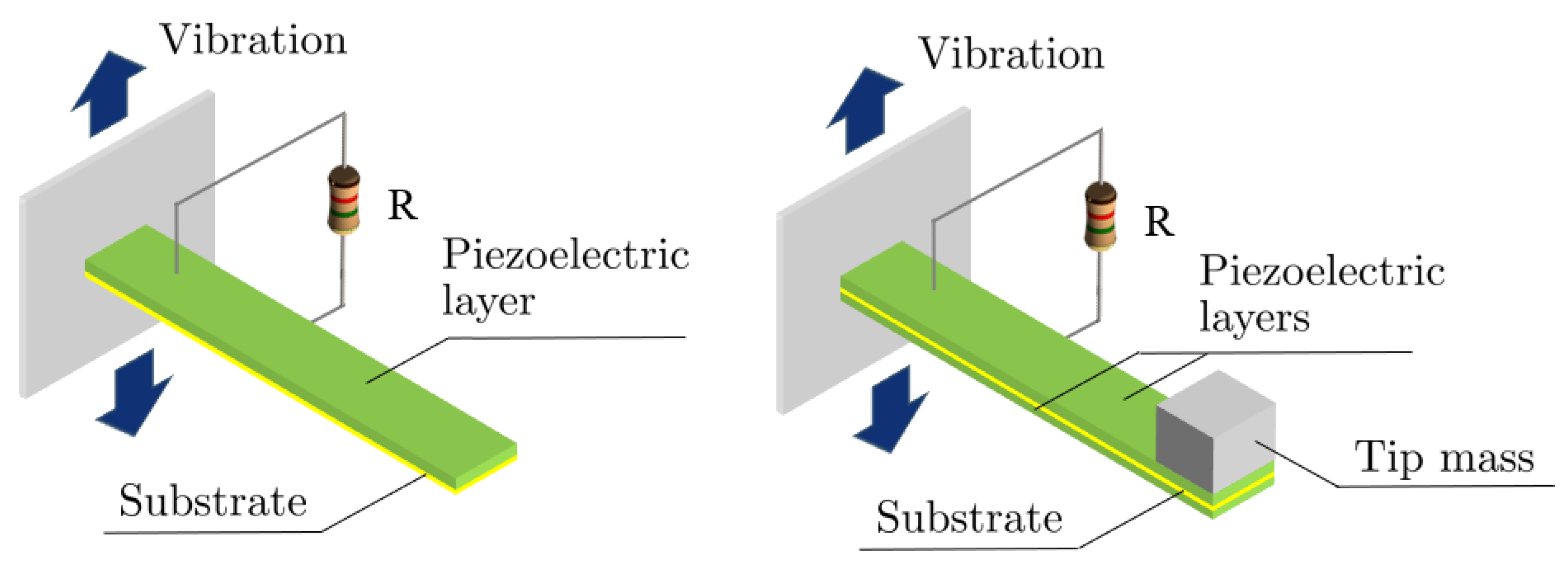
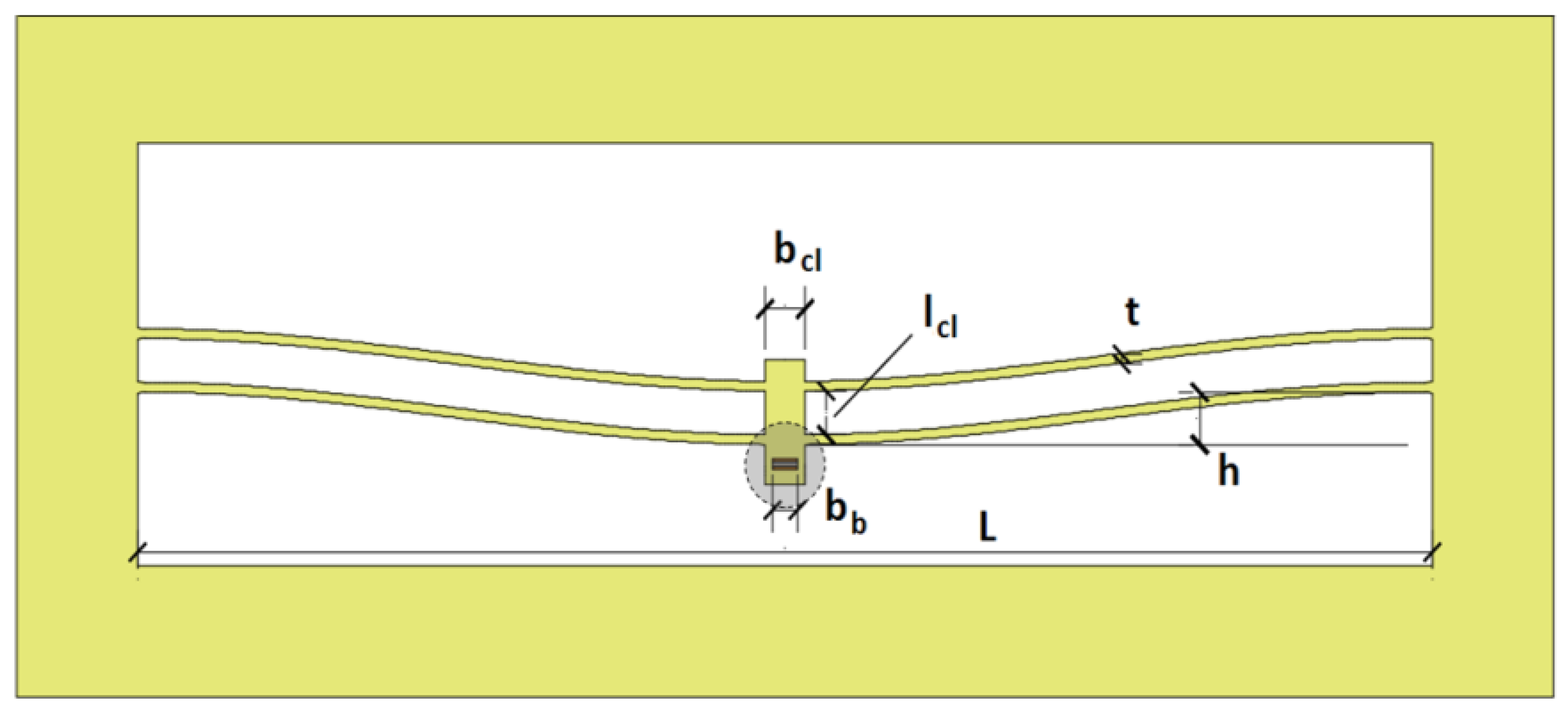

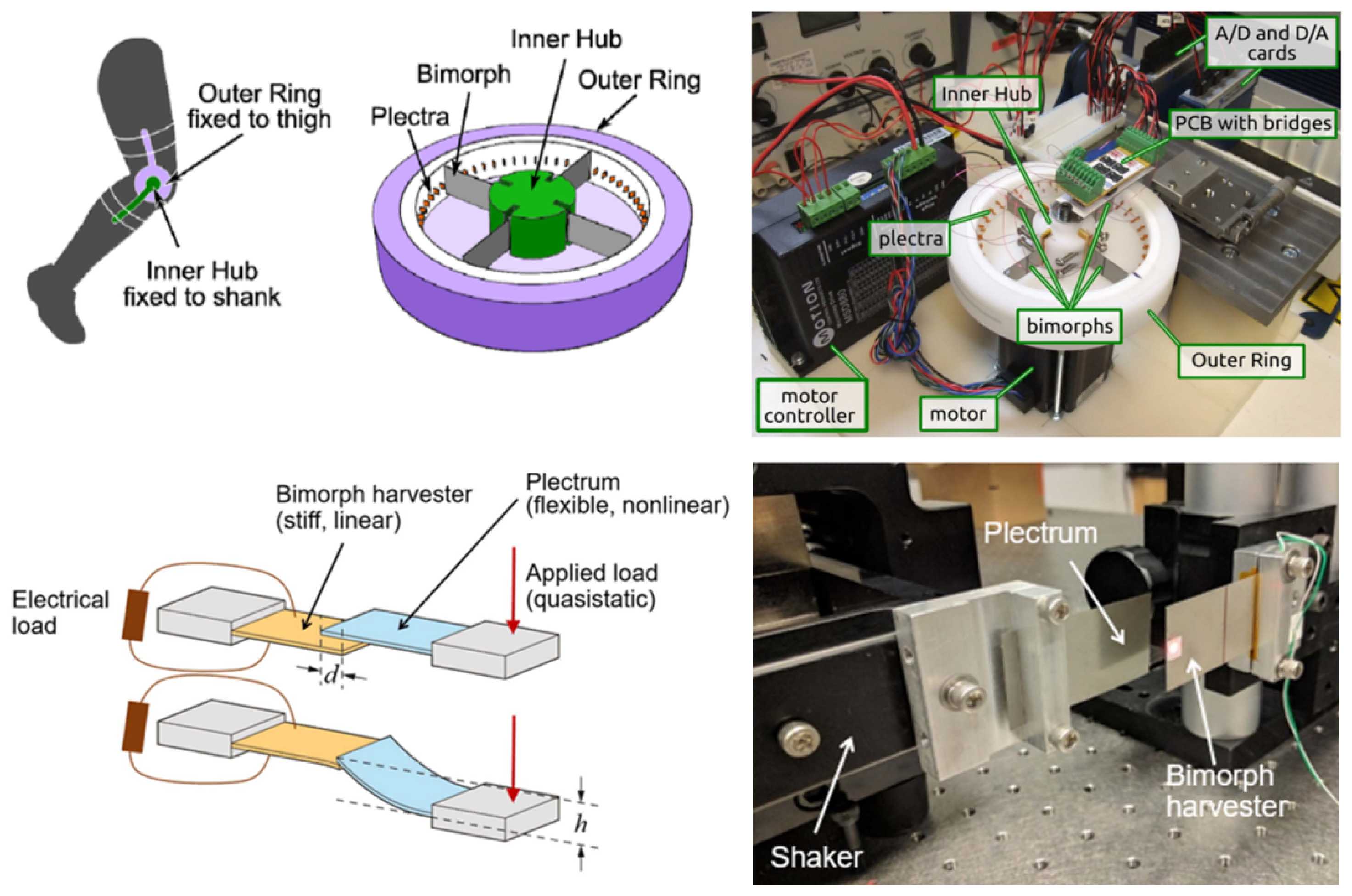
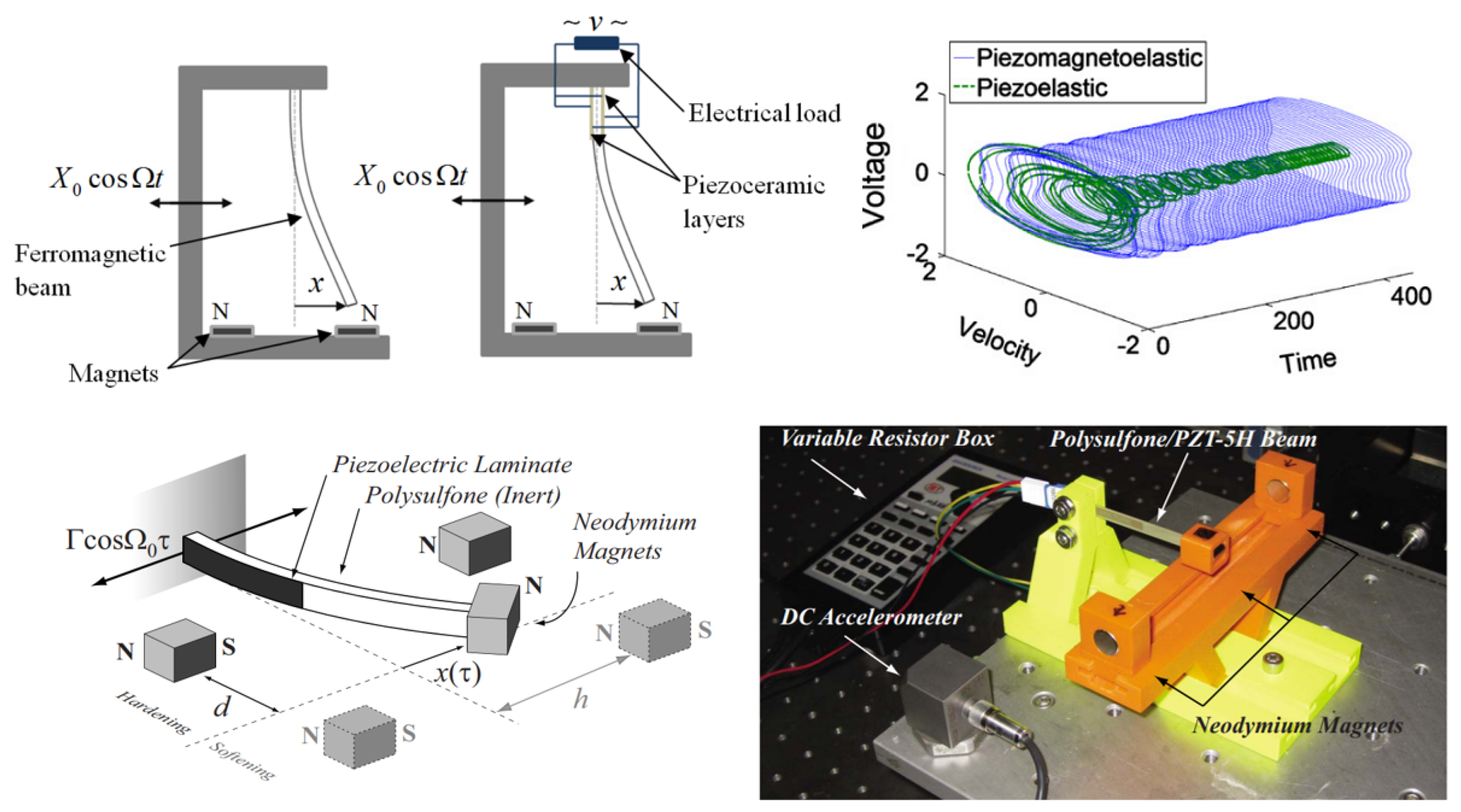
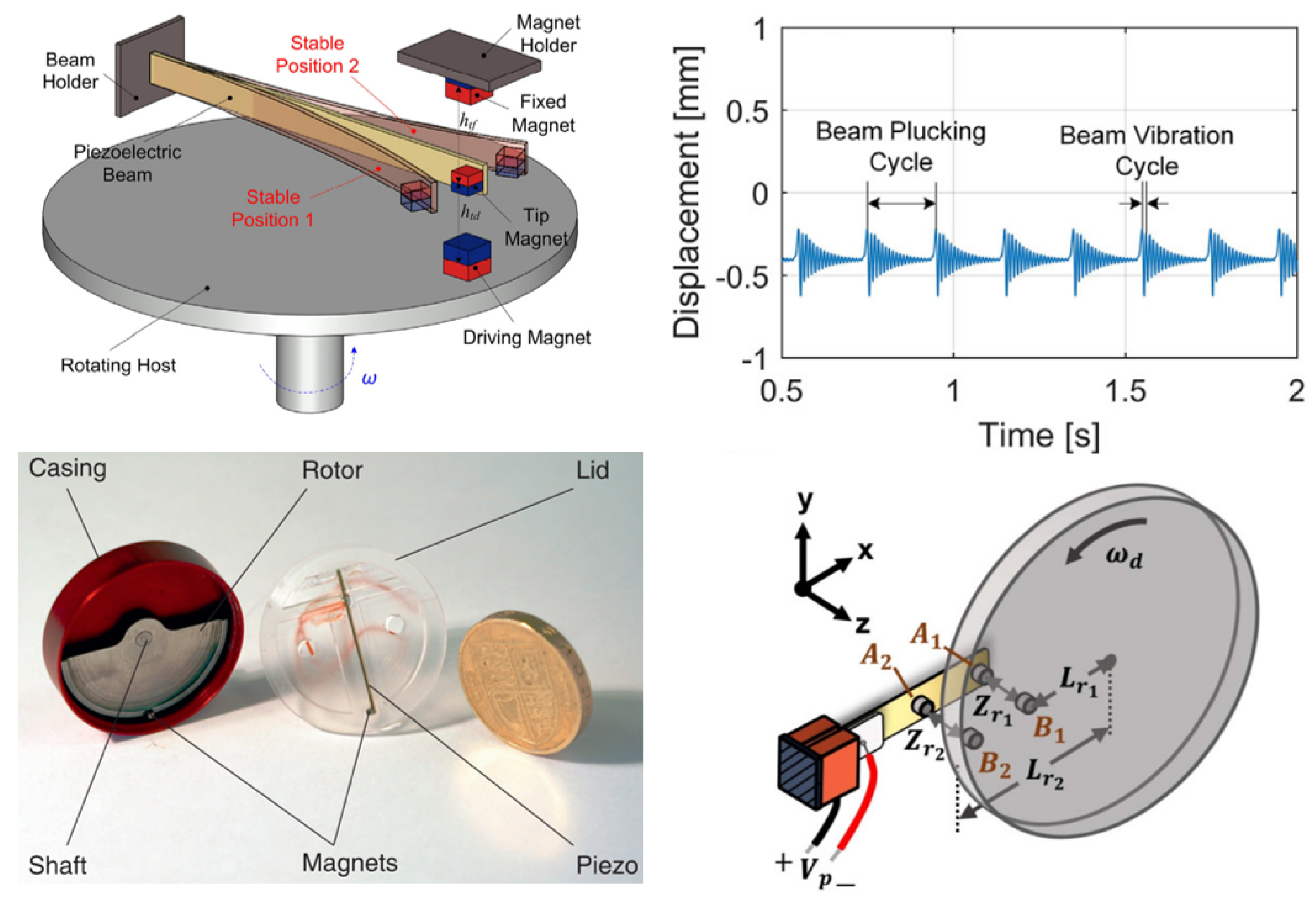
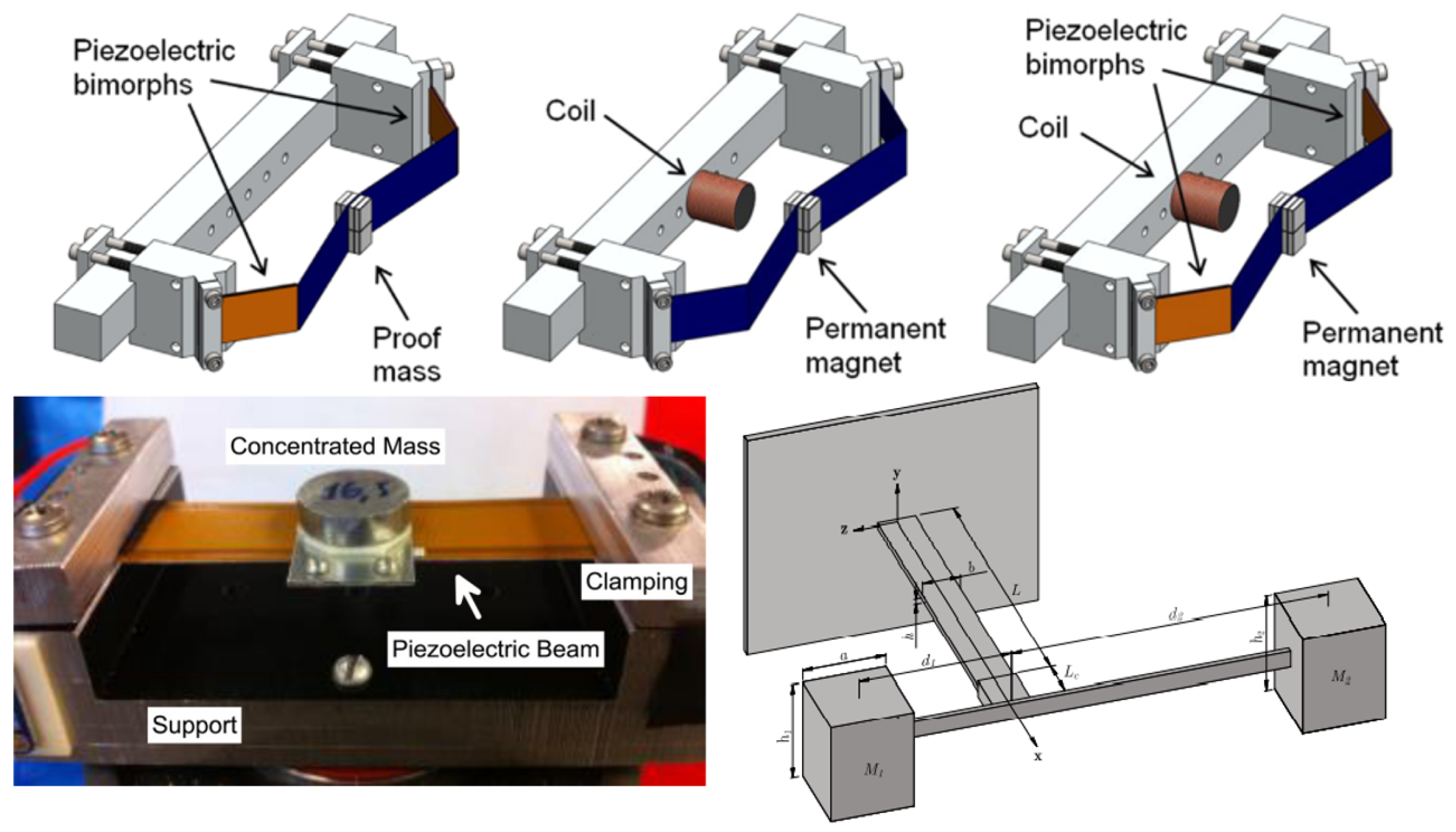
Disclaimer/Publisher’s Note: The statements, opinions and data contained in all publications are solely those of the individual author(s) and contributor(s) and not of MDPI and/or the editor(s). MDPI and/or the editor(s) disclaim responsibility for any injury to people or property resulting from any ideas, methods, instructions or products referred to in the content. |
© 2023 by the authors. Licensee MDPI, Basel, Switzerland. This article is an open access article distributed under the terms and conditions of the Creative Commons Attribution (CC BY) license (https://creativecommons.org/licenses/by/4.0/).
Share and Cite
Rosso, M.; Ardito, R. A Review of Nonlinear Mechanisms for Frequency Up-Conversion in Energy Harvesting. Actuators 2023, 12, 456. https://doi.org/10.3390/act12120456
Rosso M, Ardito R. A Review of Nonlinear Mechanisms for Frequency Up-Conversion in Energy Harvesting. Actuators. 2023; 12(12):456. https://doi.org/10.3390/act12120456
Chicago/Turabian StyleRosso, Michele, and Raffaele Ardito. 2023. "A Review of Nonlinear Mechanisms for Frequency Up-Conversion in Energy Harvesting" Actuators 12, no. 12: 456. https://doi.org/10.3390/act12120456
APA StyleRosso, M., & Ardito, R. (2023). A Review of Nonlinear Mechanisms for Frequency Up-Conversion in Energy Harvesting. Actuators, 12(12), 456. https://doi.org/10.3390/act12120456







